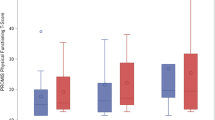Abstract
Purpose
To assess the equivalence of self-reports of physical functioning between pediatric respondents to the English- and Spanish-language patient-reported outcomes measurement information system (PROMIS®) physical functioning item banks.
Methods
The PROMIS pediatric physical functioning item banks include 29 upper extremity items and 23 mobility items. A sample of 5091 children and adolescents (mean age = 12 years, range 8–17; 49% male) completed the English-language version of the items. A sample of 605 children and adolescents (mean age = 12 years, range 8–17; 55% male; 96% Hispanic) completed the Spanish-language version of the items.
Results
We found language (English versus Spanish) differential item functioning (DIF) for 4 upper extremity items and 7 mobility items. Product-moment correlations between estimated upper extremity and mobility scores using the English versus the equated Spanish item parameters for Spanish-language respondents were 0.98 and 0.99, respectively. After excluding cases with significant person misfit, we found DIF for the same 4 upper extremity items that had DIF in the full sample and for 12 mobility items (including the same 7 mobility items that had DIF in the full sample). The identification of DIF items between English- and Spanish-language respondents was affected slightly by excluding respondents displaying person misfit.
Conclusions
The results of this study provide support for measurement equivalence of self-reports of physical functioning by children and adolescents who completed the English- and Spanish-language surveys. Future analyses are needed to replicate the results of this study in other samples.






Similar content being viewed by others

References
Cella, D., Riley, W., Stone, A., Rothrock, N., Reeve, B., Young, S., et al. (2010). Initial item banks and first wave testing of the patient-reported outcomes measurement information system (PROMIS) network: 2005–2008. Journal of Clinical Epidemiology, 63(11), 1179–1194.
DeWitt, E. M., Stucky, B. D., Thissen, D., Irwin, D. E., Langer, M., Varni, J. W., et al. (2011). Construction of the eight-item patient-reported outcomes measurement information system pediatric physical function scales: Built using item response theory. Journal of Clinical Epidemiology, 64(7), 794–804.
Yang, F. M., Heslin, K. C., Mehta, K. M., Yang, C.-W., Oceptek-Welikson, K., Kleinman, M., et al. (2011). A comparison of item response theory-based methods for examining differential item functioning in object naming test by language of assessment among older Latinos. Psychological Test and Assessment Modeling, 53, 440–460.
Hays, R. D. (2011). Response 1 to Reeve’s chapter: Applying item response theory for questionnaire evaluation. In J. Madans, K. Miller, A. Maitland, & G. Willis (Eds.), Question evaluation methods: Contributing to the science of data quality (pp. 125–135). Hoboken: Wiley.
Paz, S. H., Spritzer, K. L., Morales, L. S., & Hays, R. D. (2013). Evaluation of the patient-reported outcomes information system (PROMIS®) Spanish physical functioning items. Quality of Life Research, 22(7), 1819–1830.
Reise, S. P. (1990). A comparison of item- and person-fit methods of assessing model-data fit in IRT. Applied Psychological Measurement, 14, 127–137.
Skinner, C., Wright, V. R., Aratani, Y., et al. (2010). English language proficiency, family economic security, and child development. National Center for Children in Poverty website. http://www.nccp.org/publications/pub_948.html.
Toluna Group Ltd. https://us.toluna.com/.
Barona, A., & Miller, J. A. (1994). Short acculturation scale for Hispanic youth (SAS-Y): A preliminary report. Hispanic Journal of Behavioral Sciences, 16, 155–162.
Eremenco, S. L., Cella, D., & Arnold, B. J. (2005). A comprehensive method for the translation and cross-cultural validation of health status questionnaires. Evaluation and the Health Professions, 28(2), 212–232.
Wild, D., Eremenco, S., Mear, I., et al. (2008). Multinational trials-recommendation on the translations required, approaches to using the same language in different countries, and the approaches to support pooling the data: The ISPOR patient reported outcome translation and linguistic validation good practice task force report. Value in Health, 12, 430–440.
Muthén, L. K., & Muthén, B. O. (1998). Mplus user’s guide (6th ed.). Los Angeles: Muthén & Muthén.
Reeve, B. B., Hays, R. D., Bjorner, J. B., Cook, K. F., Crane, P. K., Teresi, J. A., et al. (2007). Psychometric evaluation and calibration of health-related quality of life item banks: Plans for the patient-reported outcome measurement information system (PROMIS). Medical Care, 45, S22–S31.
Choi, S., Gibbons, L., & Crane, P. (2011). Lordif: An R package for detecting differential item functioning using iterative hybrid ordinal logistic regression/item response theory and Monte Carlo simulations. Journal of Statistical Software, 39(8), 1–30.
Stocking, M. L., & Lord, F. M. (1983). Developing a common metric in item response theory. Applied Psychological Measurement, 7(2), 201–210.
Drasgow, F., Levine, M. V., & Williams, E. A. (1985). Appropriateness measurement with polytomous item response models and standardized indices. The British Journal of Mathematical and Statistical Psychology, 38, 67–68.
Kincaid, J., Fishburne, R., Rodgers, R., & Chissom, B. (1975). Derivation of new readability formulas for Navy enlisted personnel (Branch Report 8-75). Millington: Chief of Naval Training.
Hays, R. D., Liu, H., & Kapteyn, A. (2015). Use of internet panels to conduct surveys. Behavior Research Methods, 47(3), 685–690.
Funding
This work was supported by the National Cancer Institute (Grant Number 1U2-CCA186878-01), National Institute on Aging (Grant Number P30-AG02168), and National Institute on Minority Health and Health Disparities (Grant Number P20-MD000182).
Author information
Authors and Affiliations
Corresponding author
Ethics declarations
Conflicts of interest
All authors declare no conflicts of interest.
Ethical approval
All procedures performed were in accordance with the ethical standards of the institutional and/or national research committee and with the 1964 Helsinki declaration and its later amendments or comparable ethical standards.
Informed consent
Informed consent was obtained from all individual participants included in the study.
Rights and permissions
About this article
Cite this article
Hays, R.D., Calderón, J.L., Spritzer, K.L. et al. Differential item functioning by language on the PROMIS® physical functioning items for children and adolescents. Qual Life Res 27, 235–247 (2018). https://doi.org/10.1007/s11136-017-1691-5
Accepted:
Published:
Issue Date:
DOI: https://doi.org/10.1007/s11136-017-1691-5



